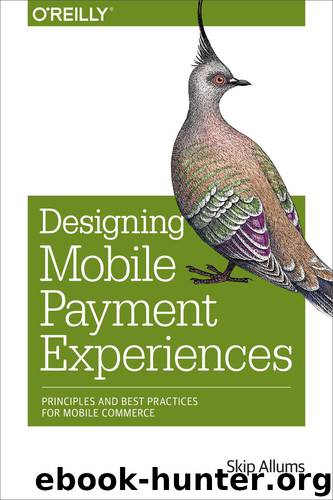Designing Mobile Payment Experiences: Principles and Best Practices for Mobile Commerce by Allums Skip

Author:Allums, Skip
Language: eng
Format: epub
Tags: COMPUTERS / User Interfaces
ISBN: 9781449366308
Publisher: O'Reilly Media
Published: 2014-08-13T04:00:00+00:00
Figure 4-18. LevelUp gives the user several attempts before a final warning, after which she’ll be locked out
Figure 4-19. Brazil-based Iugu uses gesture patterns to lock its QR code–based wallet
Handling Sensitive Data
Developers should take great care never to expose information about users that would compromise their personal or financial privacy. This includes not only data sets like card numbers and PINs, but also identifiable information like location data, full names, and billing addresses. The easiest way to avoid exposure is not to use them in the first place! This is not really possible, of course. Whether they use closed loop reloadable cards (e.g., Starbucks) or a secure element embedded deep in the phone’s innards (e.g., Isis Wallet), all payment apps rely on the user offering up some kind of funding source.
There are two areas in this regard that concern users the most: visual feedback during data entry of their accounts and cards, and the resulting display of those accounts and cards in UI elements. The first scenario is rather straightforward: whenever users enter a credit card number, security code (CVV, CVM), password, or PIN, obfuscate the field so that they can see what they entered for about one second before the app replaces that value with a dot or asterisk.
The second scenario — displaying account information as part of the interface — is trickier.
We want users to be able to readily recognize their accounts or cards in a list, and select them to do things like transfer money between accounts or reload a prepaid card. When displaying credit and debit cards, avoid revealing more than the last four digits of the card number, as shown in Figure 4-20. Offer users the option to give their cards nicknames (like “My Debit Card” or “Gas Card”), so that they don’t have to rely on the card number alone for identification. Displaying card images provided by the issuing bank is also helpful, but avoid storing and using an actual photo of the card.
Download
This site does not store any files on its server. We only index and link to content provided by other sites. Please contact the content providers to delete copyright contents if any and email us, we'll remove relevant links or contents immediately.
The Mikado Method by Ola Ellnestam Daniel Brolund(20600)
Hello! Python by Anthony Briggs(19897)
Secrets of the JavaScript Ninja by John Resig Bear Bibeault(18203)
Dependency Injection in .NET by Mark Seemann(18105)
The Well-Grounded Java Developer by Benjamin J. Evans Martijn Verburg(17573)
Kotlin in Action by Dmitry Jemerov(17179)
Sass and Compass in Action by Wynn Netherland Nathan Weizenbaum Chris Eppstein Brandon Mathis(13260)
Secrets of the JavaScript Ninja by John Resig & Bear Bibeault(11381)
Jquery UI in Action : Master the concepts Of Jquery UI: A Step By Step Approach by ANMOL GOYAL(9385)
Svelte with Test-Driven Development by Daniel Irvine(8139)
Test-Driven Development with PHP 8 by Rainier Sarabia(7888)
Layered Design for Ruby on Rails Applications by Dementyev Vladimir;(7707)
Web Development with Django by Ben Shaw Saurabh Badhwar(7216)
React Application Architecture for Production by Alan Alickovic(6899)
Software Architecture for Web Developers by Mihaela Roxana Ghidersa(4980)
Audition by Ryu Murakami(4887)
Accelerating Server-Side Development with Fastify by Manuel Spigolon Maksim Sinik & Matteo Collina(4836)
Solidity Programming Essentials by Ritesh Modi(4563)
Build Your Own Web Framework in Elixir by Aditya Iyengar(4437)
